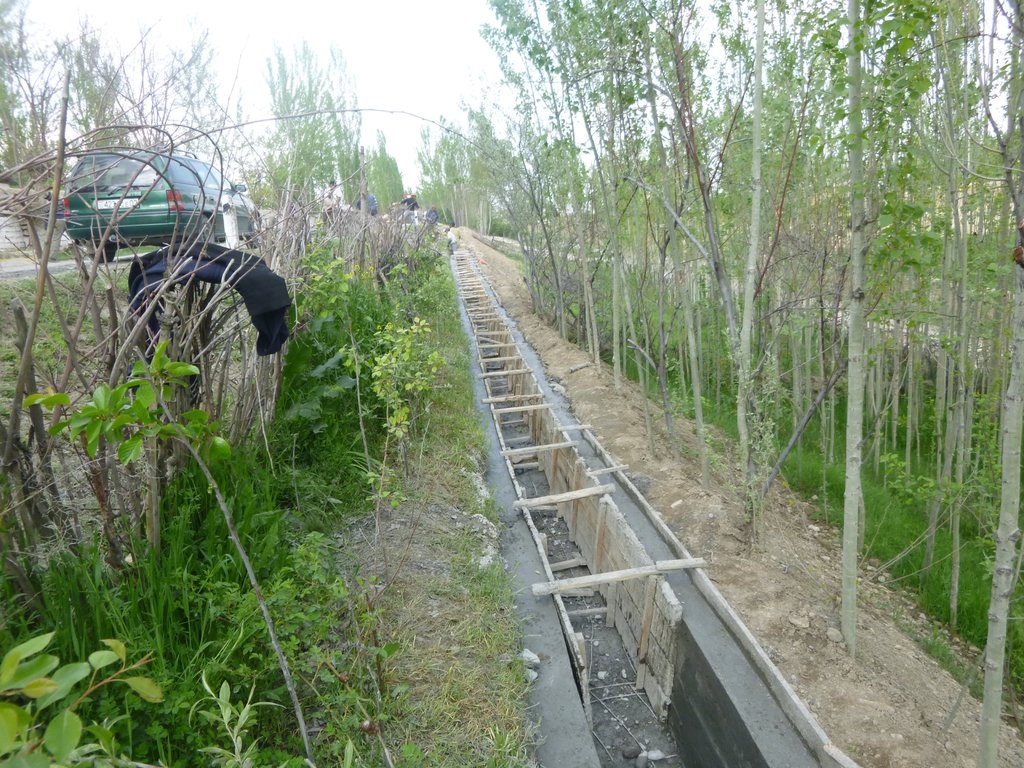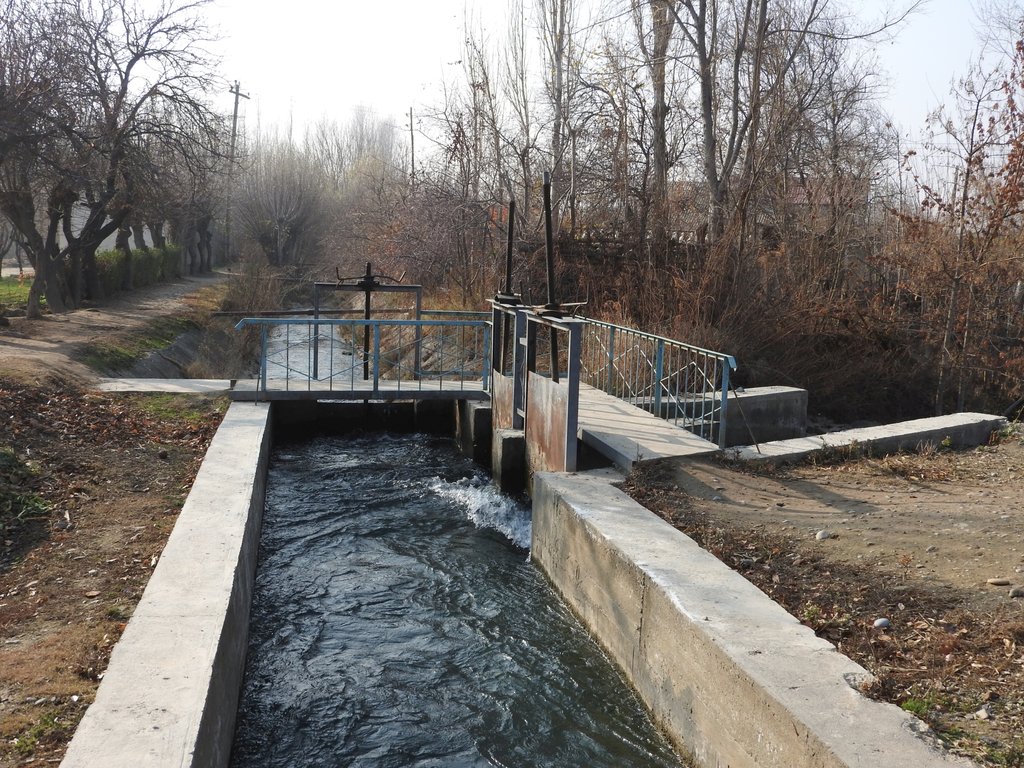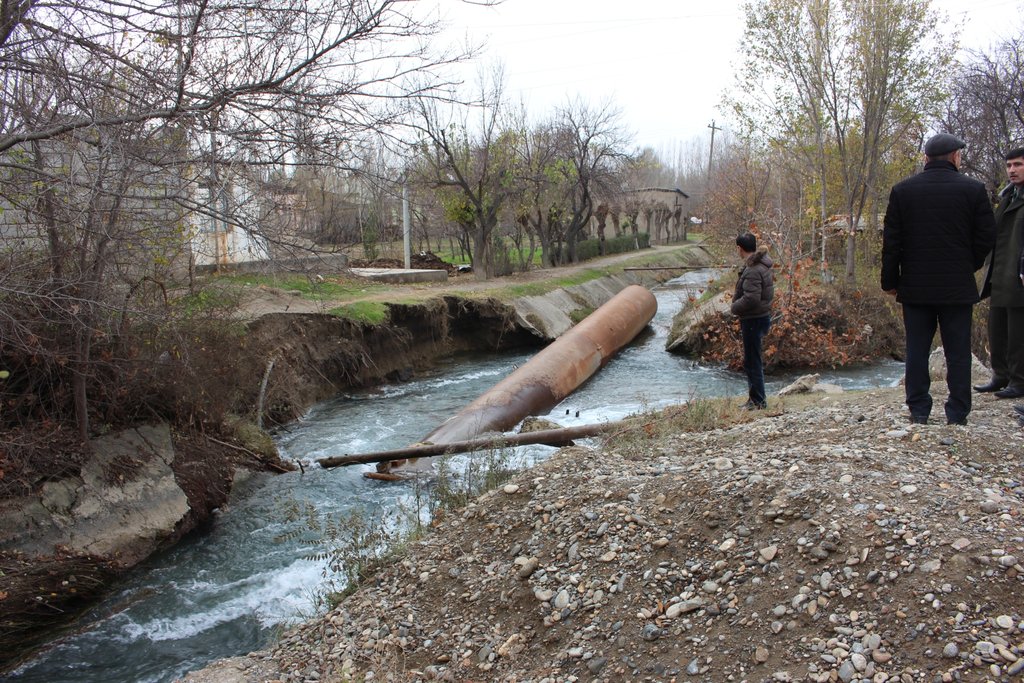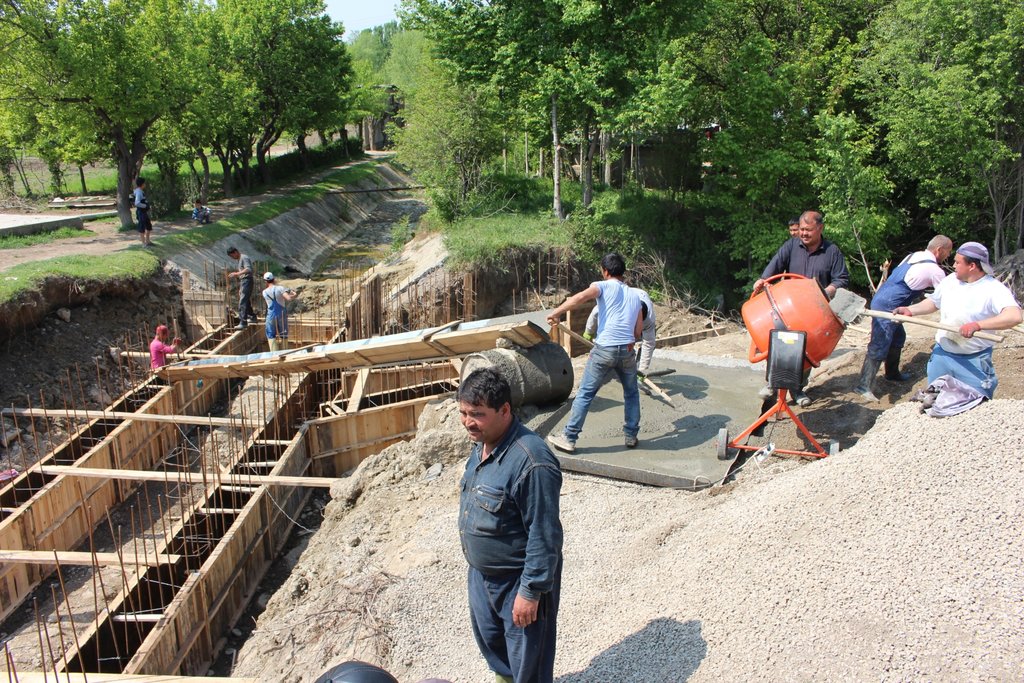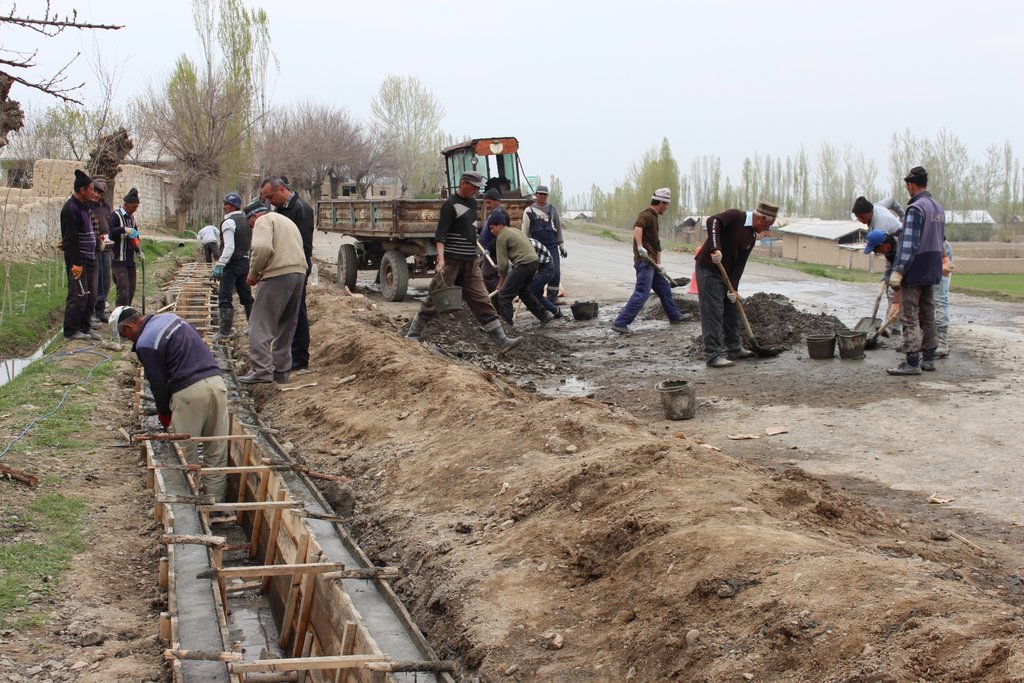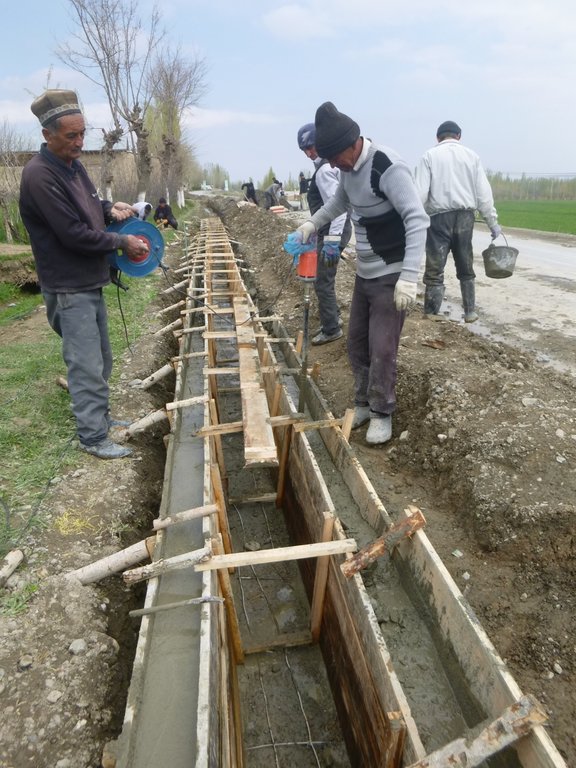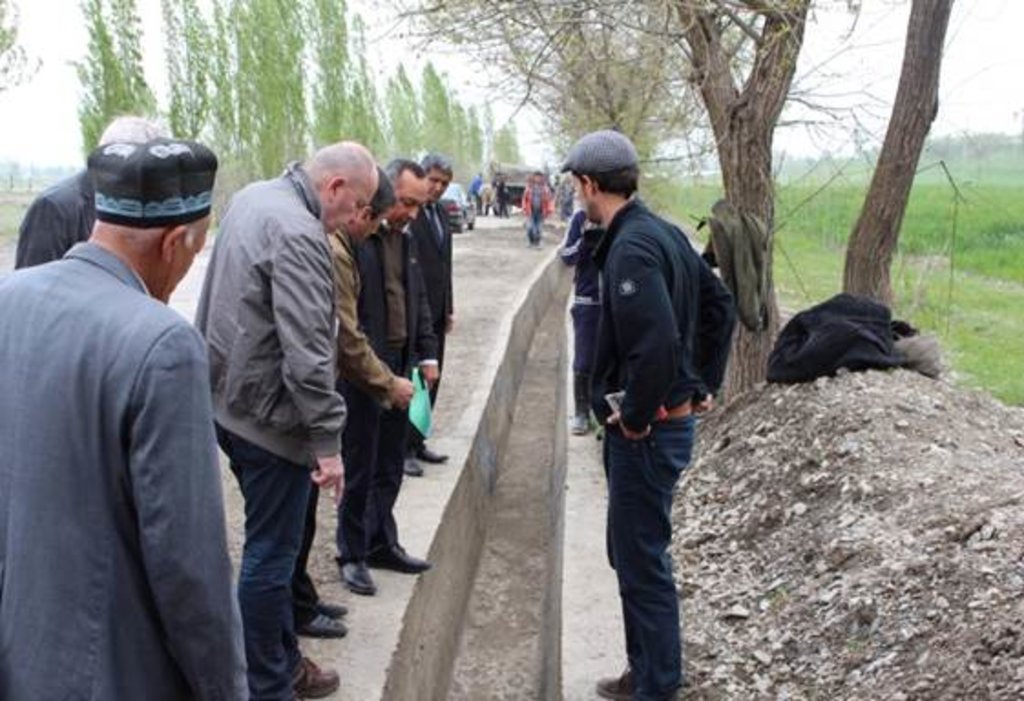Increased efficiency of irrigation water use to address climate change related water shortage [Tayikistán]
- Creación:
- Actualización:
- Compilador: Stefan Michel
- Editor: –
- Revisor: Umed Vahobov
Повышение эффективности использования ирригационной воды для решения проблемы нехватки воды, связанной с изменением климата
approaches_4318 - Tayikistán
Visualizar secciones
Expandir todo Colapsar todos1. Información general
1.2 Detalles de contacto de las personas de referencia e instituciones involucradas en la evaluación y la documentación del Enfoque
Persona(s) de referencia clave/s
Especialista MST:
Negmatov Negmatjon
negmatdzhon.negmatov@giz.de
Deutsche Gesellschaft für Internationale Zusammenarbeit (GIZ)
Tayikistán
Muhidinov Nodir
+992 92 777 0134
nodir.sfl@gmail.com
Deutsche Gesellschaft für Internationale Zusammenarbeit (GIZ)
Tayikistán
Nombre del proyecto que facilitó la documentación/ evaluación del Enfoque (si fuera relevante)
Strengthening of Livelihoods through Climate Change Adaptation in Kyrgyzstan and TajikistanNombre de la(s) institución(es) que facilitaron la documentación/ evaluación del Enfoque si fuera relevante)
GIZ Tajikistan (GIZ Tajikistan) - Tayikistán1.3 Condiciones referidas al uso de datos documentados mediante WOCAT
¿Cuándo se compilaron los datos (en el campo)?
27/11/2018
El compilador y la/s persona(s) de referencia claves aceptan las condiciones acerca del uso de los datos documentados mediante WOCAT :
Sí
1.4 Referencia/s al/los Cuestionario(s) de Tecnologías MST

Applying drip irrigation for efficient irrigation water use … [Tayikistán]
Drip irrigation substantially saves water compared to conventional furrow irrigation. Here the technology is applied for different perennial and annual crops and with use of different sources of water.
- Compilador: Stefan Michel
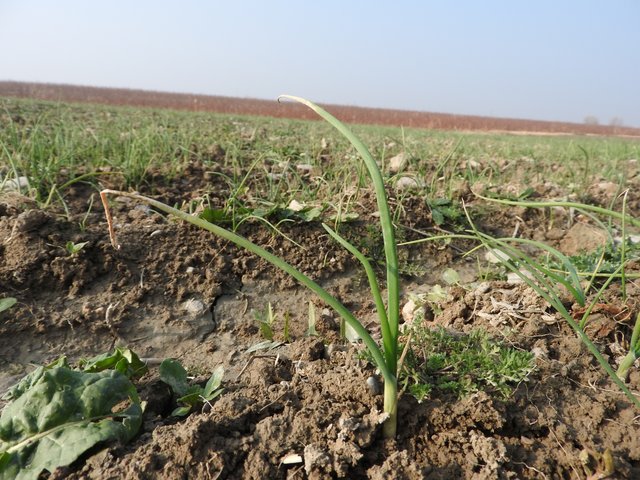
Onion production by greenhouse propagation and transplantation [Tayikistán]
Onion seeds are sown in sheeting greenhouses, where the onion seedlings are propagated. The seedlings are then replanted in the open field. This makes them less prone to extreme weather events and provides higher yield of better quality.
- Compilador: Stefan Michel
2. Descripción del Enfoque MST
2.1 Breve descripción del Enfoque
Climate change impact contributes to irrigation water shortage. The approach of improving irrigation water delivery, distribution and use prevents irrigation water losses and increases the productivity per amount of irrigation water available.
2.2 Descripción detallada del Enfoque MST
Descripción detallada del Enfoque MST:
Irrigated agriculture is in many areas limited by the availability of irrigation water. In many irrigated areas the canals delivering water to villages, distributing it between farms and the on-farm irrigation systems are in poor shape, which causes substantial water losses. The human population growth further contributes to shortages of irrigation water.
These problems are increasingly exacerbated by the impact of climate change. The already visible trends and predictions show higher levels of aridity, higher temperatures during the vegetation season, reduced overall precipitation in catchment areas, more irregular rainfall patterns, reduced snow packs and accelerated snow melt as well as the loss of glaciers as buffers of water flow. These factors all cause a reduction of available irrigation water, while higher temperatures and expansion of irrigated agriculture – partly also caused by increasing aridity and reduced feasibility of rain-fed farming – lead to higher irrigation water demand.
Additionally the increasing frequency and intensity of flashfloods, debris flows and landslides poses substantial risks to the stability and functioning of irrigation canals and thus to the livelihoods of farmers and food security.
The approach therefore aims at reducing the substantial losses of irrigation water caused be seepage from delivery and distribution canals, structural problems in irrigation systems (diversion weirs) and on-farm irrigation. It also addresses risks caused by flashfloods, debris flows and landslides. The structures between major canals, which are managed by the Water Management Departments, and the individual farms are managed by the administrative communities, the mahalla committees, which represent the inhabitants of one village or a section of a larger village. These institutions are called communal self-governance structures, but are subordinated to the government as they are reporting to te sub-district or jamoat.
For the lining of water delivery and distribution canals, the rehabilitation of associated structures and the proofing against disaster events the project conducted a participatory assessment and planning process in the local communities, but with involvement of the district water and irrigation management authorities. In the result of this process key sections for lining and repair were selected and the project further assisted with technical planning and assistance in form of purchase of materials. The communities would contribute about 28% to 39% of the overall costs, mainly in form of voluntary communal work, the so called hashar as well as in form of construction materials.
The community is also in charge of future operation and maintenance of the rehabilitated and disaster and climate proofed irrigation structures.
2.3 Fotos del Enfoque
2.5 País/ región/ lugares donde el Enfoque fue aplicado
País:
Tayikistán
Región/ Estado/ Provincia:
Sughd region
Especifique más el lugar :
Shahriston district, Sughdiyon village and J. Rasulov district, Dehmoi village
Map
×2.6 Fechas de inicio y conclusión del Enfoque
Indique año del inicio:
2015
Si no se conoce el año preciso, indique la fecha aproximada en la que se inició el Enfoque:
hace menos de 10 años (recientemente)
2.7 Tipo de Enfoque
- proyecto/ basado en un programa
2.8 Propósitos/ objetivos principales del Enfoque
Reduction of water losses from irrigation systems, improvement of irrigation water availability under conditions of climate change.
2.9 Condiciones que facilitan o impiden la implementación de la/s Tecnología/s aplicadas bajo el Enfoque
disponibilidad/ acceso a recursos y servicios financieros
- impiden
Without external support insufficient financial resources
entorno institucional
- facilitan
Existence of community level management of irrigation networks
colaboración/ coordinación de actores
- facilitan
Collaboration between water management authorities and community leaders.
conocimiento de MST, acceso a apoyo técnico
- impiden
Project assistance required to provide engineering knowledge and skills to community
carga de trabajo, disponibilidad de mano de obra
- facilitan
Tradition of voluntary joint work for community needs "hashar"
3. Participación y roles de las partes interesadas involucradas
3.1 Partes interesadas involucradas en el Enfoque y sus roles
- usuarios locales de tierras/ comunidades locales
Local community members
Participation in identification of sections for rehabilitation/improvement;
Carrying out construction works.
- gobierno local
Water management department at district level
Mahalla committee
Identification of sections for rehabilitation/improvement
Participation in planning
Organization of community work
- organización internacional
Deutsche Gesellschaft für Internationale Zusammenarbeit (GIZ)
Overall project implementation;
Technical planning and oversight;
Procurement of construction materials via competitive bidding process
Si varias partes interesadas estuvieron involucradas, indique la agencia principal:
Deutsche Gesellschaft für Internationale Zusammenarbeit (GIZ)
3.2 Involucramiento de los usuarios locales de tierras/ comunidades locales en las distintas fases del Enfoque
| Involucramiento de los usuarios locales de tierras/ comunidades locales | Especifique quién se involucró y describa las actividades | |
|---|---|---|
| iniciación/ motivación | interactivo | Local community members, indicating problem issues to community leadership, water management department and GIZ staff |
| planificación | interactivo | Involvement of community members in planning |
| implementación | auto-movilización | Local community members carrying out works through traditional voluntary community work ("hashar"). |
| monitoreo y evaluación | interactivo | Local farmers involved in monitoring of water supply. |
3.4 La toma de decisiones en la selección de Tecnología(s) MST
Especifique quién decidió la selección de las Tecnología/ Tecnologías a implementarse:
- principalmente por especialistas MST en consulta con usuarios de tierras
Explique:
Technical aspects decided by specialized engineers taking into consideration the needs and observations of community members.
Especifique las bases que sustentaron la toma de decisiones:
- la evaluación de conocimiento MST bien documentado (la toma de decisiones se basa en evidencia)
- la experiencia personal y opiniones (no documentadas)
4. Apoyo técnico, fortalecimiento institucional y gestión del conocimiento
4.1 Construcción de capacidades / capacitación
¿Se proporcionó la capacitación a usuarios de tierras/ otras partes interesadas?
No
4.2 Servicio de asesoría
¿Los usuarios de tierras tienen acceso a un servicio de asesoría?
Sí
Especifique si servicio proporcionado se realizó:
- en los campos de los usuarios de tierras
4.3 Fortalecimiento institucional (desarrollo institucional)
¿Se establecieron o fortalecieron instituciones mediante el Enfoque?
- sí, moderadamente
Especifique el nivel o los niveles en los que se fortalecieron o establecieron las instituciones:
- local
Describa la institución, roles y responsabilidades, miembros, etc.
Existing community institutions have been strengthened through joint successful implementation of the works and the need for further maintenance of irrigation system elements as common property.
Especifique el tipo de apoyo:
- financiero
- equipo
4.4 Monitoreo y evaluación
¿El monitoreo y la evaluación forman parte del Enfoque?
Sí
Si respondió que sí, ¿la documentación se utilizará para monitoreo y evaluación?
No
4.5 Investigación
¿La investigación formó parte del Enfoque?
No
5. Financiamiento y apoyo material externo
5.1 Presupuesto anual para el componente MST del Enfoque
Indique el presupuesto anual para el componente del MST del Enfoque (en US$):
60000,00
Si no se conoce el presupuesto anual preciso, indique el rango:
- 10,000-100,000
Comentarios (ej. fuentes principales de financiamiento/ donantes principales):
The number indicates the immediate construction costs of three sites, where the approach was implemented, without costs for facilitation, planning, technical supervision, monitoring and evaluation. The main source of funding was the Government of Germany via GIZ. Communities contributed 28% to 39% in form of labour and locally available construction material.
5.2 Apoyo financiero/material proporcionado a los usuarios de tierras
¿Los usuarios de tierras recibieron financiamiento/ apoyo material para implementar la Tecnología/ Tecnologías? :
Sí
Si respondió sí, especifique el tipo o los tipos de apoyo, condiciones y proveedor(es) :
Technical planning and supervision, procurement of materials and transportation funded by GIZ.
5.3 Subsidios para insumos específicos (incluyendo mano de obra)
- ninguno
Si la mano de obra de usuarios de tierras fue un insumo sustancial, ¿fue:
- voluntario?
5.4 Crédito
¿Se proporcionó crédito bajo el Enfoque para actividades MST?
No
5.5 Otros incentivos o instrumentos
¿Se usaron otros incentivos o instrumentos para promover la implementación de Tecnologías MST?
No
6. Análisis de impacto y comentarios de conclusión
6.1 Impactos del Enfoque
¿El Enfoque empoderó a los usuarios locales de tierras, mejoró el involucramiento de las partes interesadas?
- No
- Sí, un poco
- Sí, moderadamente
- Sí, mucho
Mobilization for joint work ti address problems affecting all farmers/community members
¿El Enfoque ayudó a los usuarios de tierras a implementar y mantener Tecnologías MST?
- No
- Sí, un poco
- Sí, moderadamente
- Sí, mucho
Construction and maintenance of irrigation systems of higher efficiency with reduced water losses and risk of disaster impact.
¿El Enfoque mejoró la coordinación e implementación efectiva en costos de MST?
- No
- Sí, un poco
- Sí, moderadamente
- Sí, mucho
Coordination between donor, district level water management department, community leadership and community members
¿El Enfoque movilizó/mejoró el acceso a recursos financieros para implementar MST?
- No
- Sí, un poco
- Sí, moderadamente
- Sí, mucho
Mobilization of own resources in the community and of donor funding.
¿El Enfoque mejoró el conocimiento y capacidades de los usuarios para implementar MST?
- No
- Sí, un poco
- Sí, moderadamente
- Sí, mucho
Improved technical knowledge on construction of irrigation systems minimizing water losses and reducing disaster risk.
¿El Enfoque mejoró el conocimiento y capacidades de otras partes interesadas?
- No
- Sí, un poco
- Sí, moderadamente
- Sí, mucho
Community leadership and district level water management department - improved technical knowledge on construction of irrigation systems minimizing water losses and reducing disaster risk.
¿El Enfoque construyó/ fortaleció instituciones, colaboración entre partes interesadas?
- No
- Sí, un poco
- Sí, moderadamente
- Sí, mucho
Coordination between donor, district level water management department, community leadership and community members
¿El Enfoque mitigó conflictos?
- No
- Sí, un poco
- Sí, moderadamente
- Sí, mucho
More efficient water delivery and distribution reduces conflict about access to irrigation water within the community and between villages.
¿El Enfoque empoderó a grupos en desventaja social y económica?
- No
- Sí, un poco
- Sí, moderadamente
- Sí, mucho
Mobilization of all community members to contribute to activities with common benefits.
¿El Enfoque alentó a jóvenes/ la siguiente generación de usuarios de tierras a involucrarse con MST?
- No
- Sí, un poco
- Sí, moderadamente
- Sí, mucho
Mobilization of all community members to contribute to activities with common benefits.
¿El Enfoque resultó en mejor seguridad alimentaria/ mejoró la nutrición?
- No
- Sí, un poco
- Sí, moderadamente
- Sí, mucho
Reduced shortage of irrigation water and reduced risk of failure of irrigation systems due to disasters led to secure yields in irrigated agriculture and improved food security.
¿El Enfoque llevó a un acceso mejorado a tierra y saneamiento?
- No
- Sí, un poco
- Sí, moderadamente
- Sí, mucho
Water from irrigation canals is partly also used for household needs.
¿El Enfoque mejoró la capacidad de los usuarios de tierras a adaptarse a los cambios climáticos/ extemos y mitigar desastres relacionados al clima?
- No
- Sí, un poco
- Sí, moderadamente
- Sí, mucho
Increased resilience to climate change related irrigation water shortage by improved efficiency of water delivery and distribution; Reduced proneness of irrigation system to natural disaster, the frequency and intensity of which is increasing due to climate change.
¿El Enfoque llevó a oportunidades de empleo, ingresos?
- No
- Sí, un poco
- Sí, moderadamente
- Sí, mucho
Indirectly by providing secure access to sufficient irrigation water for farming.
6.2 Motivación principal del usuario de la tierra para implementar MST
- producción incrementada
Sufficient water available for irrigated agriculture
- reducción del riesgo de desastres naturales
Proneness of irrigation system to flashfloods, debris flows and similar events.
- mitigación de conflicto
Reduced conflict over access to irrigation water.
6.3 Sostenibilidad de las actividades del Enfoque
¿Pueden los usuarios de tierras sostener lo que se implementó mediante el Enfoque (sin apoyo externo)?
- sí
Si respondió que sí, describa cómo:
Maintenance of irrigation systems through contributions of all water users and join voluntary work ("hashar").
6.4 Fortalezas/ ventajas del Enfoque
| Fuerzas/ ventajas/ oportunidades desde la perspectiva del usuario de la tierra |
|---|
| Access to technology and materials, which would not affordably without external support. |
| Secure and sufficient supply of irrigation water. |
| Reduced risk of failure of irrigation system caused by natural disaster during critical times (irrigation period). |
| Fuerzas/ ventajas/ oportunidades desde la perspectiva del compilador o de otra persona de referencia clave |
|---|
| Same as land users' perspective. |
| Mobilization of resources of the land users and their community. |
| Strengthening of collaboration between district level water management departments, community leadership and community members. |
6.5 Debilidades/ desventajas del Enfoque y formas de sobreponerse a ellos
| Debilidades/ desventajas/ riesgos desde la perspectiva del usuario de la tierra | ¿Cómo sobreponerse a ellas? |
|---|---|
| None |
| Debilidades/ desventajas/ riesgos desde la perspectiva del compilador o de otra persona de referencia clave | ¿Cómo sobreponerse a ellas? |
|---|---|
| None |
7. Referencias y vínculos
7.1 Métodos/ fuentes de información
- visitas de campo, encuestas de campo
- entrevistas con especialistas/ expertos en MST
Vínculos y módulos
Expandir todo Colapsar todosVínculos

Applying drip irrigation for efficient irrigation water use … [Tayikistán]
Drip irrigation substantially saves water compared to conventional furrow irrigation. Here the technology is applied for different perennial and annual crops and with use of different sources of water.
- Compilador: Stefan Michel

Onion production by greenhouse propagation and transplantation [Tayikistán]
Onion seeds are sown in sheeting greenhouses, where the onion seedlings are propagated. The seedlings are then replanted in the open field. This makes them less prone to extreme weather events and provides higher yield of better quality.
- Compilador: Stefan Michel
Módulos
No se hallaron módulos



